Do you have a question about the Triumph Tiger XCX and is the answer not in the manual?
Explains the meaning of Warning, Caution, and Note symbols used in the handbook.
Explains the motorcycle's design for on-road and light off-road use.
Stresses the importance of wearing protective riding gear for safety.
Provides critical safety advice on riding under the influence, fatigue, and licensing.
Identifies the locations of important safety warning labels on the motorcycle.
Diagram and list of identifiable parts for Tiger 800 XR models.
Diagram and list of identifiable parts for Tiger 800 XC models.
Identification of motorcycle parts from the rider's perspective.
Details the location of the Vehicle Identification Number (VIN) for recording.
Details the location of the Engine Serial Number for recording.
Introduces the two types of instrument displays: TFT and LCD.
Provides a detailed table of contents for the TFT instrument display functions.
Explains the meaning and function of various warning lights and indicators.
Covers adjusting display settings, riding modes, units, and other configurations.
Details ignition, engine immobilizer, and handlebar switch functions.
Explains how to enable and disable the Anti-lock Braking System (ABS).
Guidelines for activating, adjusting, and deactivating cruise control.
Instructions for installing and removing luggage systems like panniers.
Essential daily checks to ensure a safe and reliable ride.
Procedure for safely stopping the motorcycle's engine.
Step-by-step instructions for starting the motorcycle's engine.
Detailed instructions and warnings for effective and safe braking techniques.
Explanation of how the ABS system works and its warning light indicators.
Instructions for safely parking the motorcycle in various conditions.
Information on potential hazards of adding accessories and carrying luggage.
Guidelines for correctly loading the motorcycle and panniers for stability.
Advice for carrying passengers safely and considerations for their comfort and stability.
Importance of scheduled maintenance and dealer recommendations for longevity.
Instructions for inspecting, changing, and specifying engine oil.
Information on tire types, marking, pressures, wear, and replacement.
Detailed instructions for battery removal, maintenance, disposal, and installation.
Instructions for headlight adjustment and bulb replacement procedures.
Guidelines for regular motorcycle cleaning to preserve appearance and prevent corrosion.
Precautions to take before washing to protect sensitive areas from water.
Steps after washing, including removing covers and testing brakes.
Steps to prepare the motorcycle for long-term storage.
Model specific dimensions, weights, and performance figures.
Technical specifications for the motorcycle's engine type, displacement, and ratios.
Specifications for transmission type, clutch, drive chain, and gear ratios.
List of approved tires and dual purpose tires for the motorcycle.
Explains the meaning of Warning, Caution, and Note symbols used in the handbook.
Explains the motorcycle's design for on-road and light off-road use.
Stresses the importance of wearing protective riding gear for safety.
Provides critical safety advice on riding under the influence, fatigue, and licensing.
Identifies the locations of important safety warning labels on the motorcycle.
Diagram and list of identifiable parts for Tiger 800 XR models.
Diagram and list of identifiable parts for Tiger 800 XC models.
Identification of motorcycle parts from the rider's perspective.
Details the location of the Vehicle Identification Number (VIN) for recording.
Details the location of the Engine Serial Number for recording.
Introduces the two types of instrument displays: TFT and LCD.
Provides a detailed table of contents for the TFT instrument display functions.
Explains the meaning and function of various warning lights and indicators.
Covers adjusting display settings, riding modes, units, and other configurations.
Details ignition, engine immobilizer, and handlebar switch functions.
Explains how to enable and disable the Anti-lock Braking System (ABS).
Guidelines for activating, adjusting, and deactivating cruise control.
Instructions for installing and removing luggage systems like panniers.
Essential daily checks to ensure a safe and reliable ride.
Procedure for safely stopping the motorcycle's engine.
Step-by-step instructions for starting the motorcycle's engine.
Detailed instructions and warnings for effective and safe braking techniques.
Explanation of how the ABS system works and its warning light indicators.
Instructions for safely parking the motorcycle in various conditions.
Information on potential hazards of adding accessories and carrying luggage.
Guidelines for correctly loading the motorcycle and panniers for stability.
Advice for carrying passengers safely and considerations for their comfort and stability.
Importance of scheduled maintenance and dealer recommendations for longevity.
Instructions for inspecting, changing, and specifying engine oil.
Information on tire types, marking, pressures, wear, and replacement.
Detailed instructions for battery removal, maintenance, disposal, and installation.
Instructions for headlight adjustment and bulb replacement procedures.
Guidelines for regular motorcycle cleaning to preserve appearance and prevent corrosion.
Precautions to take before washing to protect sensitive areas from water.
Steps after washing, including removing covers and testing brakes.
Steps to prepare the motorcycle for long-term storage.
Model specific dimensions, weights, and performance figures.
Technical specifications for the motorcycle's engine type, displacement, and ratios.
Specifications for transmission type, clutch, drive chain, and gear ratios.
List of approved tires and dual purpose tires for the motorcycle.
| Engine Type | Liquid-cooled, 12 valve, DOHC, in-line 3-cylinder |
|---|---|
| Displacement | 800 cc |
| Transmission | 6-speed |
| Fuel System | Multipoint sequential electronic fuel injection |
| Tires Front | 90/90-21 |
| Tires Rear | 150/70 R17 |
| Power | 94 hp (70 kW) @ 9, 500 rpm |
| Torque | 79 Nm |
| Front Suspension | WP 43mm upside down forks |
| Rear Suspension | WP monoshock, adjustable rebound damping, 215 mm travel |
| Front Brakes | Twin 305mm discs, Brembo 2-piston calipers, ABS |
| Rear Brakes | Single 255mm disc, Nissin single piston caliper, ABS |
| Seat Height | 840 mm |
| Fuel Tank Capacity | 19 litres |
| Wet Weight | 474 lbs (215 kg) |
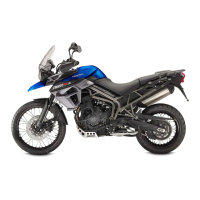

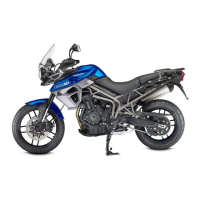
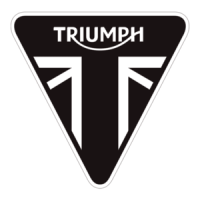
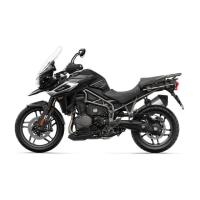


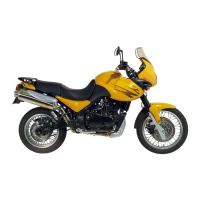
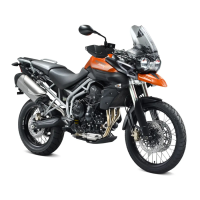
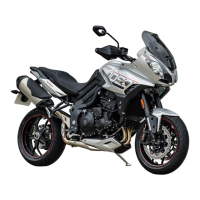
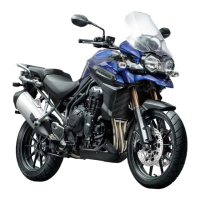
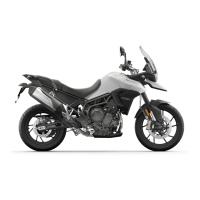
